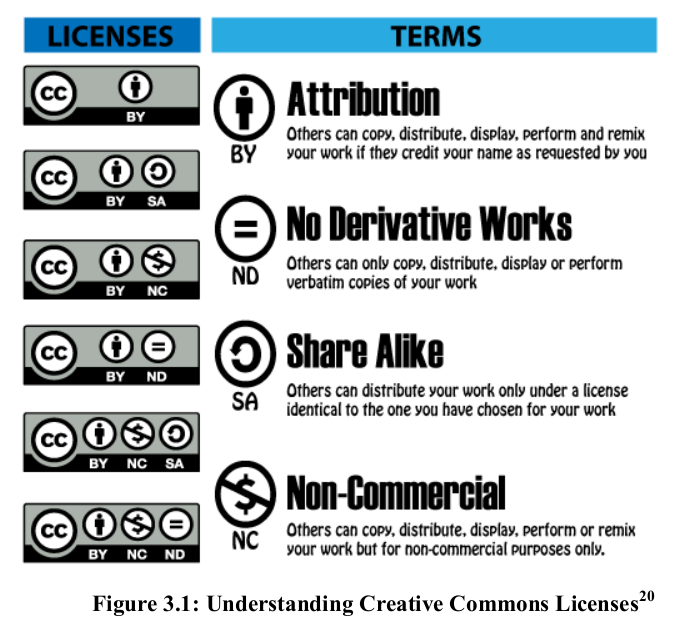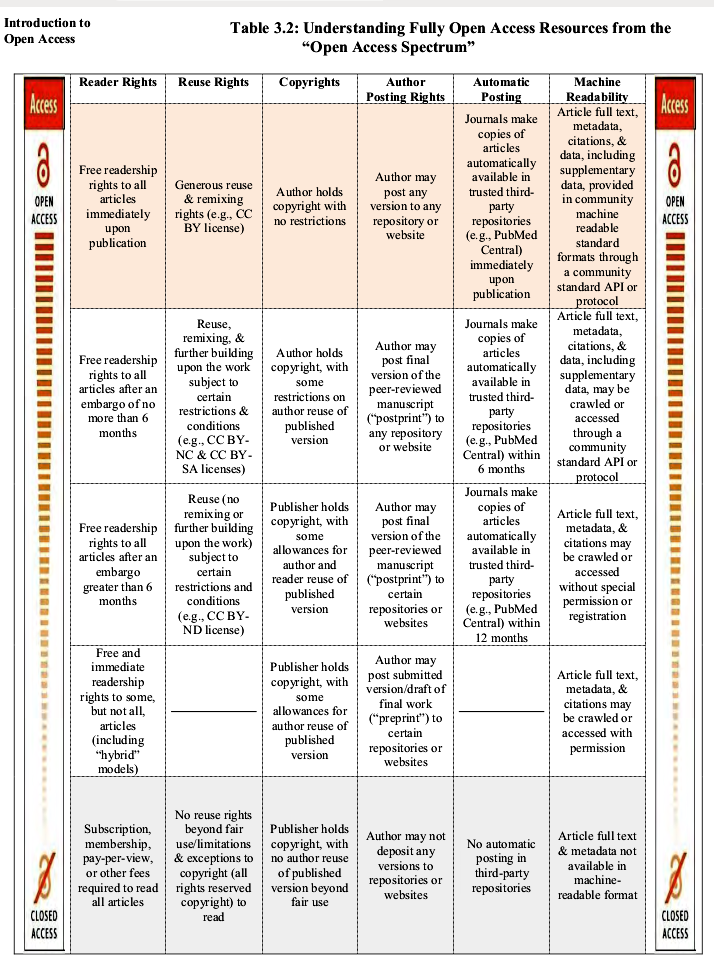3.3 Open Licenses
As seen in Table 3.1, there are two major alternatives to Copyright regime for protecting author’s rights as well as users’ freedom of use, reuse, share, distribution and modification of the original work. Copyleft and Creative Commons licenses become very helpful to the knowledge communities which are intended to guarantee your freedom to share, use, reuse, and change. Some popular forms of open licences are briefly introduced in the following paragraphs.
Copyleft
Copyleft is a general method for marking a creative work as freely available to be modified, and requiring all modified and extended versions of the creative work to be free as well. The believers of Copyleft movement are concerned over well-funded corporate strategies to privatize and commodification of all human knowledge, creativity, and meaning. This movement strives to build an alternative to the current restrictive regime of intellectual property controls. The movement sarcastically kept its slogan “All wrongs reserved.” GNU General Public License of the GNU Project, supported by the Free Software Foundation, follows the principles of Copyleft. Copyleft is a feature of most open source software (OSS) licenses.
GNU General Public License
The GNU General Public License (GNU-GPL or GPL) was originally written by Richard Stallman of the Free Software Foundation (FSF) for the GNU project. It was formally launched in 1989 as GPL version 1.0. It is the most widely used free software license, which guarantees end users (individuals, organizations, companies) the freedom to use, study, share (copy), and modify the computer software. Computer software that ensures that these rights are retained is called free software.
Open Content License
OpenContent Licensing (OCL) is another form of open license launched in 1998. It is mostly used in technical documentation, software manual and other related projects. The Wiki Books project also has adopted OPL for online distribution. Its derivative version Open Publication License (OPL) was released in 1999 as OPL version 1.0. The Copyleft, GNU-GPL and OPL have been the collective and community efforts to produce shareable and modifiable computer software, technical literature and creative contents. These licences are also aimed at reducing overdependence from the multinational and large corporations, trying to hold community knowledge for their profits.
Creative Commons
While the Copyleft, GNU-GPL and OPL licenses mainly cater to the purposes of computer software and technical documentations, the Creative Commons (CC) licenses are preferred in scholarly communications as well as in creative audio-visual communications. Creative Commons, launched in 2001 as a non- profit organization, is an outcome of larger community movements, embracing the notions of freedom of sharing, reusing and modifying scholarly or artistic contents for knowledge re-creation and optimal utilization. Creative Commons in scholarly communications environment becomes the Science Commons that ensures open access to research literature and research data. As shown in Figure 3.1, there are six types of CC licenses, namely CC BY, CC BY-SA, CC BY-NC, CC BY-ND, CC BY-NC-SA, and CC BY-ND. Here ND stands for no derivative works, SA stands for share-alike, and NC stands for non-commercial. The most liberal term is CC BY, where users can copy, distribute, display, perform and remix an author’s work if they credit author’s name as requested by the author. The most restrictive term is CC BY-NC-ND, where users can copy, distribute, display, and perform verbatim copies of an author’s work but for non-commercial purposes only.

Open Access Spectrum:
Table 3.2 shows a tabular representation of different rights available to a creator or author who opts to publish an open access publication. Such rights and attributes are the Reader Rights, Reuse Rights, Copyrights, Author Posting Rights, Automatic Posting, and Machine Readability. Some of these rights are also extended to users’ community, in case of open access publications, allowing them to use, reuse, remix or share. This Table is drawn from an advocacy toolkit “HowOpenIsIt?TM Open Access Spectrum”, jointly published by the SPARC (Scholarly Publishing and Academic Resources Coalition), PLOS (Public Library Of Science) and OASPA in 2014 and licensed under CC BY. The top most row indicates most generous rights available to an open access publication, with a CC BY license, where authors as well as users have rights related to reusing, sharing, archiving, self-archiving, copying, distributing, translating, machine reading and all other fair use. Whereas bottom most row indicates most restrictive rights for a closed access publication, where neither creators nor users have rights related to reusing, sharing, archiving, self-archiving, copying, distributing, translating, or machine reading. This tabular spectrum also gives a glimpse of broader view of an open access publication vis-à-vis narrower view a publication in copyright regime. The publications licensed under CC BY-ND offer more restrictive rights than the publications licensed under CC BY-SA or CC BY-NC. Similarly, the publications licensed under CC BY offer more liberal rights than the publications licensed under CC BY-SA or CC BY-NC. Since the last decade we have observed the exponential growth of open access publishers as well as joining of toll-access publishers in open access scholarly publishing domain. The Open Access Scholarly Publishers Association (OASPA), founded in 2008, has become an industry association representing open access publishers for sustenance of gold OA publishing model. OASPA recommends implementation of CC BY license by their member publishers so that OA contents can be reused and distributed through commercial and non-commercial channels. However, OASPA usually opposes implementation of CC BY-SA or CC BY-NC-ND licenses by their member publishers, as discussed in Text Box 3.2, as these licenses are more restrictive and non-beneficial to them. The publishers receiving article processing charge (APC) from the authors of accepted papers in their OA journals or OA articles in hybrid journals usually grant CC BY license to their contents. Whenever authors insist to have more restrictive ones such as CC BY-SA or CC BY-NC-ND licenses, they need pay premium APC – higher than regular APC for granting CC BY license.
Major OA publishers, such as, PLOS, BioMed Central and eLife, have been publishing papers with appropriate CC licenses, as suggested or approved by authors’ respective research funders. Other OA publishers, particularly, which are from the developing countries, need to implement standardized OA licenses suitable for global researchers and research funders.

